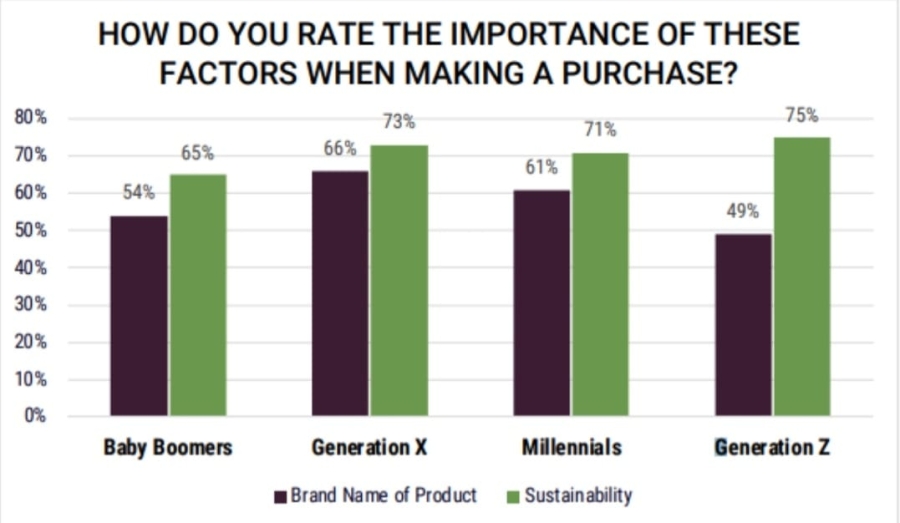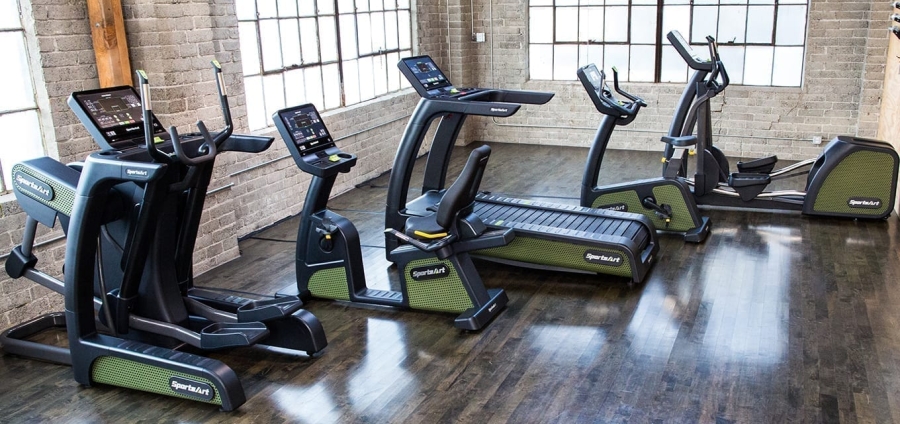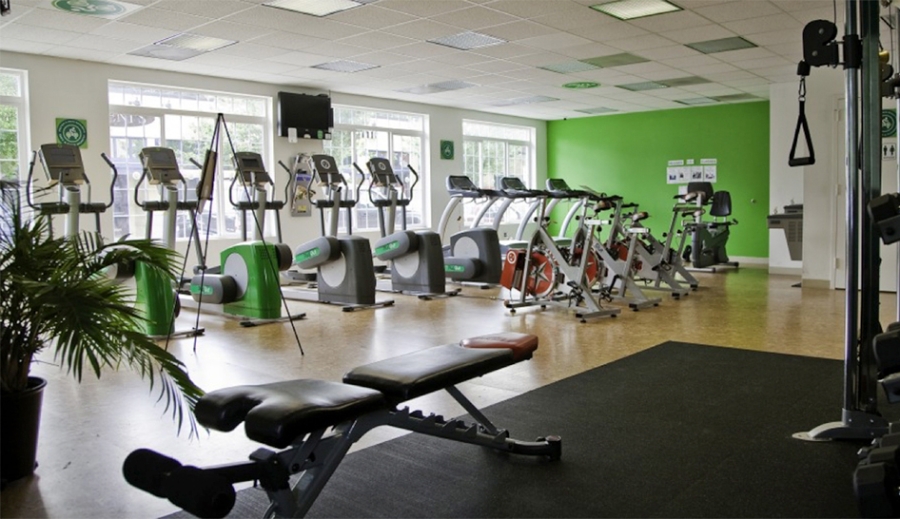Eco-conscious consumers are demanding sustainability from brands across all industries, including health and fitness.

Eco-conscious consumers are demanding sustainability from brands across all industries, including health and fitness.
How can this expectation be applied to gyms and fitness facilities?
Innovative gym equipment capable of producing electricity is undoubtedly the most sophisticated (yet costly) option.
Luckily, high-tech equipment converting calories into watts it is not the only way for your gym to go green. It is all about being able to develop and maintain legitimate, eco-friendly practices.
Let's first look at the generational analysis research on the subject.
When it comes to purchase decision factors, environmental responsibility is most important to Gen Z (people born between the nineties and the noughties).

Millennials also feel involved - according to Nielsen (via WickedBionic), 75 per cent of people born between 1981 and 1996 say they care about eco-friendliness enough to change their purchase habits. What is more, 75 per cent of them are also ready to pay more for eco-friendly products.
According to a Les Mills Research Lab study, Millennials and Gen Z represent 80% of all gymgoers and they are collectively referred to as "Generation Active".
The data is really interesting from the perspective of a gym owner because it suggests that a large portion of your member base likely consider themselves environmentally responsible, at least to some extent.
While going green matters for societal reasons, implementing eco gym strategies doesn't have to be just a passion project. Environmentally responsible tactics also make a lot of sense from the business perspective, helping you save money.
From the perspective of your members, eco-innovations can inspire an exercise kick in some people, as well as help create a sustainable environment in the long term. Knowing that every single workout helps fend off climate change can be the extra push someone may need on a hard day.
By definition, sustainability "seeks to prevent the depletion of natural or physical resources, so that they will remain available for the long term."
Sustainable products and services focus on catering to the needs of the current generation while protecting the future ones.
Here's the starter kit of an environmentally responsible fitness business.

Source: Pexels
The impact of plastic waste on the environment is devastating. Most plastic products are discarded quickly after use, but plastic takes over a whopping 400 years to degrade naturally. Here's a list of things you can do as an eco-aware gym owner to reduce plastic waste:
First of all, disinfecting equipment is non-negotiable and you should not encourage your members to save paper this way.
What you can do, however, is limit the use of paper for admin and promotional purposes.
What is more, modern gym management software allows you to reduce the amount of paper you're producing as a business.
Gyms and fitness facilities typically consume enormous amounts of water, especially on filling pools, running showers, operating toilets and urinals, heating, air conditioning, and cleaning.
Now, onto the most appealing of eco concepts that have been around for quite some time now.
The green fitness equipment trend comes as stark contrast to the traditional gyms which are the epitome of consumption with loud music, air con, and energy-sucking machines.
The whole point of an eco-gym is to create net zero energy workouts or even send utility grade electricity back to the grid. While right now no gyms run solely on electricity generated from workouts, it could be the future of the fitness world.
The beauty of green exercise equipment is that the workout itself remains unchanged. Eco gyms are just taking advantage of the energy users create anyway which is then given back to the grid.
If you're new to the concept, here are the brands you simply need to know.

Source: SportsArt
SportsArt's equipment helps change the world with every single workout, aiming to revolutionize the way we think about cardio. The company has been producing exercise equipment for 45 years and quite some time ago, their team began working on green energy machines. Their ECO-line of products was launched back in 2014.
SportsArt's patented technology ECO-POWR™ is turning human energy into electricity. The company boasts of converting up to "74% of human energy produced into clean, renewable energy."
SportsArt equipment motivates its users with engaging impact metrics like watts generated, as well the cumulative impact of member contribution to the environment. They also help gym owners by offsetting costs, especially those of electrical bills.
Unfortunately, for now, their indoor cycling equipment is unable to power the whole gym, let alone the entire building. Even when the gym is fully equipped with treadmills, recumbent bikes, and other indoor cycling equipment, consumption is higher than supply.
The Imaginarium is a Rochester-based Art and Science Center at I-Square. It features restaurants, an art gallery, rooftop solar panels, vertical gardens, wind turbines, and finally, a gym equipped with electricity producing exercise machines from SportsArt.
The whole building is energy-efficient and able to return energy produced by the gymgoers, wind turbines, and solar panels to the grid when their production is greater than usage.
The Green Microgym

Adam Boesel is the founder of The Green Microgym company specializing in energy-generating indoor cycling equipment. His micro green fitness center uses approximately 85% less electricity per square foot compared to traditional gyms.
Boesel admits that one of the biggest challenges of turning human energy into electricity is not explaining how the equipment works, but "the disappointment people experience when they are faced with the hard truth that their pedalling is not going to power their entire home."

While the idea seems appealing, workout-powered fitness appliances aren't enough to create a sustainable environment. Green workouts are part of a bigger puzzle.
This technology could also be utilized to motivate people to work out at home. Though equally (or even more) appealing, this wattage is insufficient to power the whole house, let alone the entire building.
How would you feel if a gym with energy-producing equipment mixed all their recycling or consciously used yoga mats made of carcinogenic materials?
Here are some rules sustainability-focused brands should always abide by to resonate with their audiences.
The number one piece of advice when marketing to eco-conscious audiences is to not make false claims. Not delivering on your promises, greenwashing, or making false claims is a recipe for building the opposite of brand loyalty.
Instead of making huge claims, start with the eco-friendly sustainable practices mentioned above.
Greenwashing is the practice of pretending "to be environmentally conscious for marketing purposes but actually isn’t making any notable sustainability efforts." Sometimes companies greenwash even with good intentions. Regardless of their reasons, greenwashing always leads to violating consumer trust.
As consumers continue to embrace environmental causes, they seek brands that work on making the world a better place.
While energy self-sufficiency is by far the most appealing of all eco gym trends, you should start with making meaningful changes that require less of an investment.
It starts with taking the first step and helping your members recycle, as well as keep plastic, water, and paper waste to a minimum.
Discover how our innovative solutions can elevate your business. Request a demo today and see the difference firsthand. Let's grow, together!
